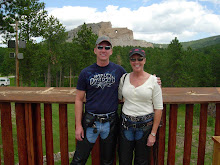The French followed Marshal Rold's deployment to the "T". I think this created some initial opportunities for the Austrians as they exploited their superior deck and CiC (12+1) to set the tone and tempo of the battle. The Austrians closed on the French left, while holding their own right with a slim force of a brigade (Ed's) of Hungarian infantry and their 3 cavalry regiments.
Greg's Austrian assault at the hinge of the French line at the corner of the ridge near the French baseline succeeded in destroying half of the French artillery and creating a hole.....that couldn't be exploited. Greg's assault force was severely punished, and spent the rest of the game rolling to rally, it seemed. Meanwhile Chris closed with the largest Austrian infantry force on the far French left flank, and also deployed a grand battery on the ridge running across the width of the battlefield. Things looked bleak for Eric, the French commander of the French left.
General Shockey was perfecting the "ooze" assault method, as his strong force of French infantry and all the cavalry stumbled their way from the far French right to put pressure on Ed's troops. About this time, national Bavarian hero, John Mumby, launched an assault down the valley towards the remnants of Greg's assault force. This seemed to throw all kinds of kinks into the Austrian planning.
Chris methodically set about dismantling Eric's French - who gave as good as they got on the French left.
Ed launched his Hussars in a gallant attack down into the valley towards the Bavarian infantry's flank.....only to suffer a 3 UI loss from French and Bavarian artillery on the far ridge. So much for the Austrian cavalry trying anything aggressive from that point forward.
By this point, it looked like the Austrians had it in the bag. The French were down to their last couple of morale points, as Chris kept the pressure up on Eric's French.
Suddenly, out of the mist, from the land that time forgot - General Shockey's ooze assault burst onto the hill held by Ed's Hungarians. Before they could reach the Hungarians, the French surrendered their first chip to the Austrians!!!
The French hung on, not turning an Army Morale card, as Terry's assault mangled Ed's command.
At this point, the French were at 0 morale points, and the Austrians had 2!
Initiative to the French....first card - not an Army Morale card.
Next card.......Army Morale!!!!
Chris rolled the D12 for the Austrians and rolled an 8. OUCH.
Terry nervously picked up the D10 (for his CiC) and got ready to roll the test.....needing a 9 or 10 to continue, and possibly swing the morale points over to the French side.....he rolled an 8! Tieing the Austrian roll of 8, and ending the game!!!!
At this point, the Austrians won a marginal battle victory with 2 morale points left out of 24 at the game start. The French were at 0 out of 23 at the start.
So - for the campaign, the Austrians won 2 marginal victories, sandwiching the single crushing French victory.
The French started the campaign with 66 Campaign Points and ended with 12.
The Austrians started the campaign with 68 Campaign Points and ended with 3.
So - the Austrians won the battle count, but lost the campaign season due to the single crushing French victory!!!
We figured that the Austrians would happily quit the war and sign some meaningless treaty, while planning on renewing the war on the French at some future point. You've got to give the Austrians credit....they mastered the art of both quitting, and not quitting.
So - here are my overall thoughts on the campaign and the battle:
Campaign:
I'm happy with the battlefield selection process and the set up.
I really, really like the simplified post battle unit effect process, and REALLY like the post battle pursuit process. Simple and easy.
I kind of miss a campaign map, but I definitely didn't miss the work. Its enough work keeping the few records that were in this campaign.
As for the battle:
You're very optimistic if you hope to march a grand battery onto its position and deploy in time to do much of anything. The Austrians managed to, but had a great deck.
Don't roll a 1 for movement.
The Austrians never used their 12+1 CiC to help rally Greg's sole intact infantry unit and silenced artillery battery. I think the 1 in 12 odds of getting eliminated are offset by the much better chance of rallying with a D12+1 vs. a D8, and the addition of those 2 units in a healthy state would probably have forced John's Bavarians to think twice about coming down the valley.
Photos from the battle follow below:












